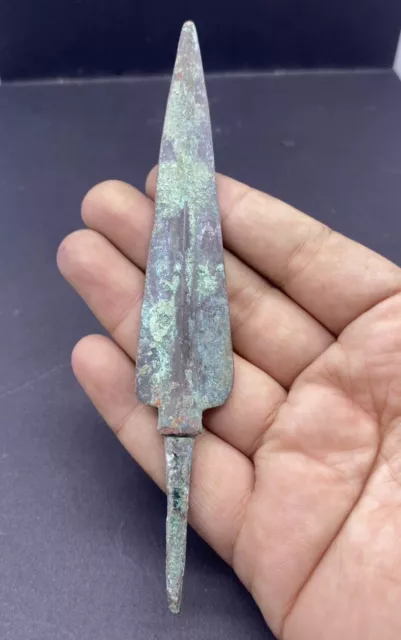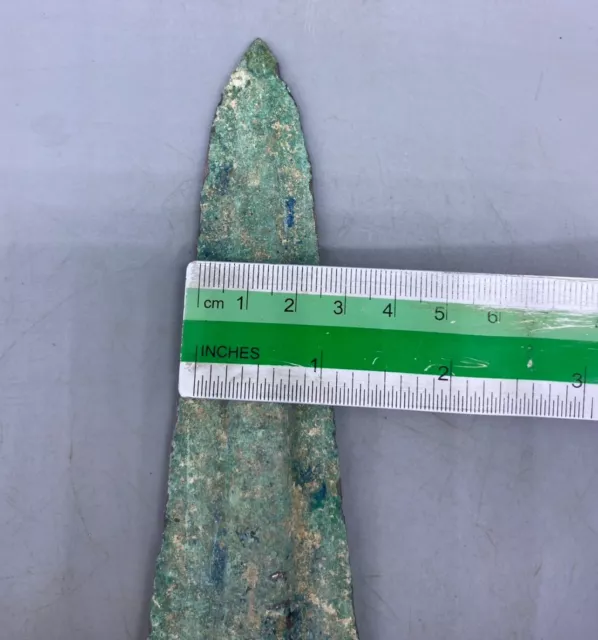Unusually Large Ancient Luristan Bronze Artillery Throwing Spear Head
This is a superbly preserved, LARGE cast and forged bronze socketed spear head from ancient Luristan of the Ancient Near East Bronze Age . The impressive quality and preservation condition of this example is exceptional with no bronze disease and a magnificent patina of the most desirable bright green hue. Its heavy weight and broad, penetrating blade design was ideal for standoff artillery barrages of thrown spears like these, to decimate and demoralize advancing enemy soldier formations. The long socket would have been affixed over a wooden shaft. The attachment holes are still intact at the base of the socket. The heavy midrib would have also keep the blade from bending and allowed armor-piercing capability while the broad cutting blade would have had devastating effect on unarmored or lightly armored enemies, as well as enemy cavalry horses. To date, this is one of the largest and finest ancient bronze Near Eastern artillery spear heads we have offered!
This artifact has been professionally cleaned and conserved in our lab, being treated with a special sealer developed and formulated by us specifically for ancient metal preservation. The patina shows beautiful traits only found in authentic ancient weapons. It is a patina like this that the finest ancient bronzes are prized for and it is a patina like this that brings a premium in price and value of the specimen. There is no active bronze disease. Bronze disease can develop on ancient bronze that is not properly cleaned and conserved. It produces a corrosive powder that will literally eat away an artifact over time and destroy it.
WARNING: There is a STAGGERING number of fake bronze weapons on the market. Many being sold as "authentic" were never meant to deceive and were made as far back as 100 years ago as exact reproductions for museums to sell in their gift shops. Other examples are modern fabrications specifically intended to fool unwitting buyers. As fine quality intact, original specimens become more scarce, the techniques to fake these objects have become highly advanced. We have personally handled numerous well-done fakes with extremely convincing patinas. The degree to which the fakers have been able to replicate patina to disguise their work requires an expert examination by highly experienced individuals. It is common to find very reasonably priced weapons that are made up of part original and part modern components or wholly modern pieces displaying elaborate artificial patinas. All purchases should include a written guarantee of authenticity from the seller, with unconditional and lifetime return policies regarding such guarantee, such as we provide.
HISTORY
With origins dating back to prehistory, the empire of ancient Iran was one of the world's first superpower civilizations by the time it had taken form in the second millennium B.C.. The various cultures that can be included in the former ancient Iranian Empire stretched across an enormous geographical region extending beyond what is called the Iranian Plateau. To gain insight as to just how large this area was, the Iranian Plateau alone, includes Iran, Afghanistan and Pakistan and comprises approximately nearly 4 million square kilometers (almost 1.5 million square miles). The area of ancient Iran included not only the massive Iranian plateau made up of the tribes of the Medes, Persians, Bactrians and Parthians, but also included groups as far west as the Scythians (an eastern Scythian tribe existed in parallel in Central Asia), Sarmartians, Cimmerians and Alans populating the steppes north of the Black Sea. To the eastern boundary of the empire, the Saka tribes dominated, spreading as far as Xinjiang, China. From a very early period, the ancient Iranian peoples have been historically documented to exist in two separate continuums - a western civilization (Persia) and an eastern civilization (Scythia).
The beginnings of ancient Iran trace back to an influx into the Iranian cultural region of bands of horse-mounted steppe nomads from Central Asia, speaking Indo-European languages. Some settled in eastern Iran but other groups migrated deeper to the west settling in the Zagros Mountains. These first people descended from the proto-Iranians, originating from the Central Asian Bronze age culture of what is called the Bactria-Margiana Complex (aka Oxus Civilization), dated 2200-1700 B.C..
This historical achievements and the breadth of diverse cultures included of this once great empire are too vast to adequately credit in this brief synopsis. The Islamic conquest of Persia in the middle of the 7th century A.D. and the collapse of the Sassanid Empire marked the end of once geographically expansive and culturally diverse ancient superpower.
The term LURISTAN references artifacts made by a society of semi-nomadic people that once lived in the mountainous region of Northwest Iran. Little is known of this ancient culture but the most impressive traces are that of the bronze artifacts they left behind that can be found in parts of present-day Turkey, Iran and Afghanistan. These include highly decorative equipment for their horses, ceremonial containers and numerous weapons ranging from simple utilitarian pieces on up to elaborate masterpieces of warfare.
It is theorized that the Luristan bronzes were crafted by the earliest existence of the Median empire but this has never been proven as written records of the Medes have not survived. The Medes were Indo-Iranian people originally from central Asia who settled in Northwest Iran in the 9th century BC and later defeated the Assyrian empire in 614 BC. Their success is short-lived and their empire which once stretched from central Iran to the Persian Gulf and Anatolia was overrun in 550 BC by the Persians.
RECOMMENDED
- Condition: Used
- Condition: Used
- Brand: Unbranded
- Primary Material: Bronze
- Era: Luristan
- Country/Region of Origin: Central Asian
- Color: Green
- Style: Antique
- Original/Reproduction: Original
- Material: Bronze
- Features: Decorated
- Unit Quantity: 1
- Age: Pre-1800
PicClick Insights - Unusually Large Ancient Luristan Bronze Artillery Throwing Spear Head PicClick Exclusive
- Popularity - 2 watchers, 0.0 new watchers per day, 60 days for sale on eBay. Good amount watching. 0 sold, 1 available.
- Best Price -
- Seller - 650+ items sold. 0.5% negative feedback. Great seller with very good positive feedback and over 50 ratings.
People Also Loved PicClick Exclusive

Finest Ancient Luristan Bronze Artillery Throwing Spearhead Of The Near East
$600.00 Buy It Now 21h 12m
Large Superb Ancient Luristan Bronze Spear Lance Head With Long Tang From Asia
$800.00 Buy It Now 23d 15h
Genuine Rare Ancients Old Roman Greek Bronze Arrows Spear Head Very RARE!!
$250.00 Buy It Now 18d 16h
Genuine Rare Ancient Roman Era Bronze Spear Head Arrow Long RARE!!
$500.00 Buy It Now 18d 15h
700-600 B.C. Ancient Luristan Bronze Spearpoint Arrowhead Persian Roman Greek
$399.00 Buy It Now 19d 8h


